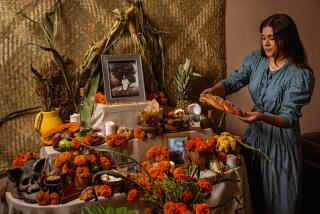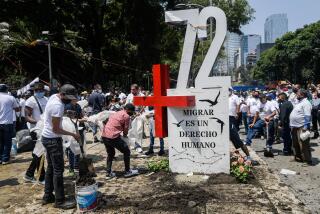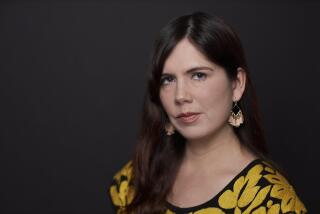The Aztec Temple of Death : THE GREAT TEMPLE OF TENOCHTITLAN Center and Periphery in the Aztec World : <i> by Johanna Broda, David Carrasco and Eduardo Matos Moctezuma (University of California Press: $38; 183 pp.) </i>
The essays that compose this volume concern the excavations of the Templo Mayor, the Vatican of the Aztec empire, and the new light the project cast upon the gruesome society destroyed by Hernan Cortez. They are written by scholars for scholars. But the material is so fascinating that a layman’s interest in the nature of humanity is all that’s needed to hold one’s attention. In fact, the careful language that scholarship requires serves to make a roomful of child-size skeletons--innocents sacrificed to satisfy the sun--seem credible. It also makes reading about ritual murder more tolerable.
Readers may remember that the Temple of Tenochtitlan was destroyed by Cortez after the Spanish conquistadors captured the Aztec capitol in 1521. They may also recall the Aztec practice of sacrificing prisoners. What these three essays make clear is how central to the Aztec culture this practice was and how the slaughter grew with the power of the empire.
I confess that even as a boy reading William H. Prescott’s “Conquest of Mexico and Peru,” I found it hard to swallow the Spanish accounts of Aztec human sacrifice. After all, “Who wins the wars writes the histories.” The parents of the children I grew up with in Oklahoma--Seminoles, Potawatomies, Blackfeet--still had some tribal “grandmother memories” of a history far different from the history I was learning in school. I grew up skeptical of Indian atrocities. Almost 40 years of subsequent association with the mild beauty of the Navajo culture and with various Pueblo tribes whose religion burdens them with social duties deepened that skepticism. But what Eduardo Matos Moctezuma, Johanna Broda and David Carrasco report about the Great Temple of Tenochtitlan leaves no room for skepticism. That massive structure in the heart of what is now Mexico City was a monument to institutionalized murder.
Matos Moctezuma served as general coordinator of Proyecto Templo Mayor when President Miguel Lopez Portillo ordered the excavation in 1978. He precedes his “History and Interpretation” of the structure with a poem in which “the window of time” appears to him. He sees ancient faces that stare back with eyes of obsidian.
“Mire el rostro de la vida y de la muerte,” the first stanza concludes. “I saw the face of life and death.”
Through the window of time, which Matos Moctezuma’s workers opened during their four-year dig, we see a temple that the warlords of the Aztecs repeatedly rebuilt and expanded. Some of this work they did to repair damage, but there was also new construction. The dig established at least seven expansions of the four sides, plus six additions to the front facade. Through much of this “new” construction, caches of offerings were found--more than 7,000. Many came as tribute from conquered territory. They ranged from the swordfish snouts that the Aztecs used in one of their more inventive forms of execution to rare feathers, artwork, skulls of sacrificed victims with eyes replaced with obsidian, jewelry and sculpture designed to hold human hearts.
Matos Moctezuma deals with the symbolism and significance of these objects, their placement, and the design of the structure itself in light of Aztec religious and political needs. Broda, an authority on the politics and economies of pre-Columbian Mexican civilizations, is concerned with the temple as “ritual space” and its use as a symbol of political power (and political terror). To an amateur like myself, however, whose core interest is in the nature of man, the most gripping of these three essays is that by Carrasco, a professor of religious history at the University of Colorado.
In his “Myth, Cosmic Terror, and the Templo Mayor,” Carrasco takes us deep into Aztec religion. He asks how a society so accomplished in sculpture, poetry, painting, astronomy and mathematics “could become so committed to cosmic regeneration through the thrust of the ceremonial knife?” How could such an artistic culture devote so much to collecting untold thousands of men, women and children to be publicly butchered, and sometimes eaten, in celebration of its feast days? He finds an answer in the mythology of the Aztec creation, and in even earlier Mesoamerican mythology. In Aztec poetry, the supernatural hero Huitzilopochtli, to whom one of the twin pyramids of the temple was devoted, dreamed of slaughter even as a fetus. He was born fully armed, and his first act was to decapitate his sister and slaughter (deaf to their pleas for mercy) most of the 400 warrior gods who followed her. The myth teaches of the creation of the cosmos predicated on the sacrificial suicide of a god. From such an origin, it is possible to see how a culture might develop valuing death over life.
And yet my neighbors, the Hopis, have an origin story in which they, like the Aztecs, emerged from the earth and migrated under supernatural guidance. But they built hospitable villages and a society dedicated to peace. My friends, the Navajos, too, emerged from the underworld and produced two heroes as fierce as Huitzilopochtli to slaughter the Enemy Gods. But the Navajos produced a culture that dreads death and a religion dedicated to keeping the individual in harmony with his brothers and his world.
“The Great Temple of Tenochtitlan” provides 60 illustrations, footnotes and bibliography. It also provides a detailed look at the center of a culture that made flowers a metaphor for murder and planned wars simply for the sake of death.
More to Read
Sign up for Essential California
The most important California stories and recommendations in your inbox every morning.
You may occasionally receive promotional content from the Los Angeles Times.










